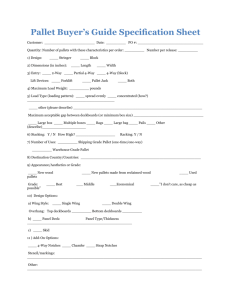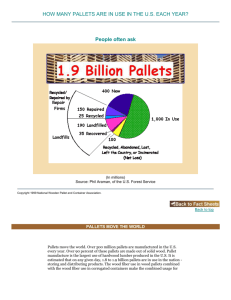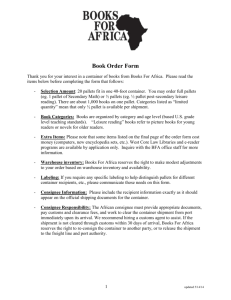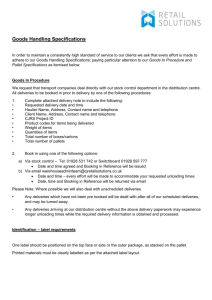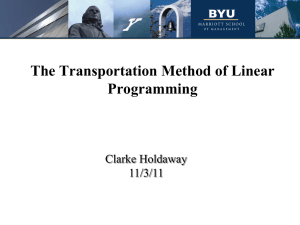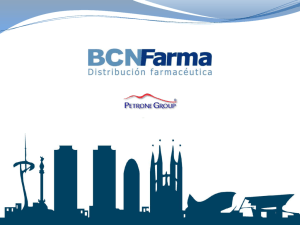Advanced Additives® Problem Background & Objectives
advertisement
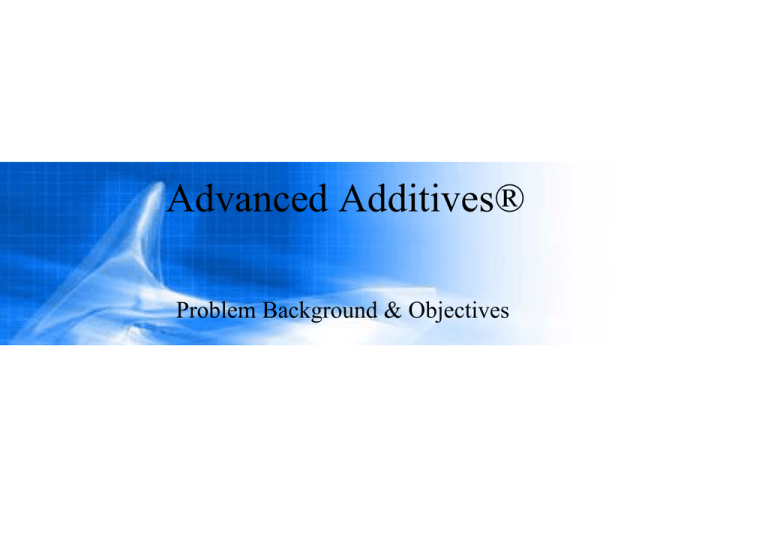
Advanced Additives® Problem Background & Objectives Company Profile Advanced Additives ® is a manufacturer and distributor of liquid and powdered products. They ship to contractors, distributors and hardware stores. Due to the current growth in the construction industry, the company needs to increase its production capabilities. A planned addition of two production lines will cause the company to look at new methods of receiving and shipping, feeding and removing products from the lines and storing raw materials and finished product. The current building cannot be expanded or replaced. Advanced Additives ® currently operates its manufacturing and shipping staff on a two shift schedule. Receiving is performed on the first shift. 15 Facility Description The facility is 183,000 square feet, inclusive of offices, with a clear height of 25 feet. Currently, 101,000 square feet is used for receiving, raw material storage and production. Offices and maintenance account for approximately 12,000 square feet. An additional 5,400 square feet of mezzanine space is used to support production lines. The remaining 70,000 sq. ft will be used for warehouse and distribution space. There are 6 shipping dock doors and 16 receiving dock doors. Due to fire regulations, empty pallets must be stored outside, which block 6 of the receiving doors. Two doors are used to stage a trash container and a broken pallet trailer. 16 Facility Description (cont.) The facility has some significant constraints inherent in its design and location. Expansion is not an option as the building is abutted by a freight rail line to the North, a river to the East and a road to the West. All receiving, shipping and employee parking occurs in the lot to the South. The yard has parking for approximately 85 cars and no trailer staging space. Currently, trailers queue along a public road waiting for doors. The space for Process 1 is unavailable for use by any other process or storage requirement. Propane which is used in Process 1 and in lift trucks is stored in the Southeast corner of the yard. Column Spacing is 40’ (N – S) x 38’ (E – W) 17 Current Facility Space (file available separately) 18 Operational Details Yard – Employee parking and trailer operations share the same space. During shift overlaps, there are more cars than available spaces. Typical trailers are 53’ and drivers are required to “jackknife” to back into the building. Empty pallets are stored outside, further exasperating the space issue. Frequent access to propane (stored in the yard) is necessary. Receiving – There are 3 positions for unloading bulk raw materials into silos from tanker trucks. On average, 24 tankers are delivered daily. It takes approximately 1.5 hours to unload a tanker. It is common that more than 3 tankers arrive at the facility simultaneously. The number of tankers will increase by 15% to support the planned growth. An “open top” trailer delivers dry goods for Process 1. The three trailers that are delivered each day are not expected to increase. This trailer requires 1 dedicated door. 19 Operational Details Receiving (cont.) – In addition to the bulk trailers, there are approximately 18-53’ trailers delivered each day. This is expected to increase by approximately 5% over the study period. Also, approximately 2 transfer trailers (trailers from other plants within the company) are received each day. The typical pallet found on the receiving dock is a standard US 48” x 40” pallet; pallet height 56 inches including pallet. Process 1 – This process is performed in the western one third of the building. 90% of raw material is delivered in bulk by pipe and 10% on pallets. It generates 3,950 pallets per month. The average weight of these pallets is 1,800 pounds and the average height is 53”. This product’s market is stable and is not expected to grow throughout the planning horizon. Finished pallets are stretch wrapped and transported to the finished goods storage on the east end of the building. They are stored in floor stacks of 6 high. 20 Operational Details Process 2 – The product from this process is in liquid form. All raw material is delivered on pallets. Plastic totes (48”x 48”x 38”) are delivered to a mezzanine mixed with additional raw materials (lifted in dry form to the mezzanine) and the finished product is filled and palletized at ground level. This area generates approximately 12,000 pallets/month. The average weight of the pallets is 1,200 pounds. The height of these pallets is 48”. The pallets are transported to the finished goods warehouse, shrink-wrapped and stored in rack to await picking and shipping. No growth is expected. Process 3 - The product from this process is also in liquid form. Water is delivered to a mezzanine via piping and is mixed with additional raw materials (lifted in dry form to the mezzanine) and the finished product is filled and palletized at ground level. 70% of the raw material is in bulk through pipes and 30% delivered on pallets. This area generates approximately 5,000 pallets/month. The average weight of the pallets is 1,700 pounds. The height of these pallets is 48”. The pallets are transported to the finished goods warehouse, shrink-wrapped and stored 21 in rack to await picking and shipping. No growth is expected. Operational Details Process 4 – The product created in this process is dry. 70% of raw material is delivered on pallets, and 30% in bulk through pipes. It is mixed and processed on a mezzanine and filled and palletized on the ground floor. There are 4 automated filling/palletizing lines and 3 manual lines. It is this process that is expected have significant growth (16%.) The growth is to be supported by the addition of two additional processing lines in another location within the building (location not determined.) This process uses significant numbers of pallets of raw materials and generates a significant amount of trash. The raw materials are lifted to the mezzanine, the trash is lowered from the mezzanine and the finished goods are removed, by pallet, all from the same travel aisle. This area currently generates 8,400 pallets per month. The average weight of the pallets is 1,900 pounds. The typical pallet is 32”x 31”x 44”high. The pallets are transported to the finished goods warehouse, shrink-wrapped and stored either in rack or on the floor (3 high stack) to await picking and shipping. 22 Operational Details Material handling Raw materials are pulled by the pallet and transported to the appropriate line. Unused product is re-warehoused. All raw materials, except water, are delivered via lift truck. Lift trucks used for all material handling are propane sit-down counter-balanced. Picking is accomplished by using the sit-down trucks and pallet jacks. Pallet wrapping is accomplished by a pallet conveyor-fed automatic wrapper. The wrapper is capable of wrapping 50 pallets/hour. 23 Operational Details Finished Goods Storage – Storage is accomplished by various modules. See drawing Pallet rack – 110” x 36” deep single deep racks ( 4 levels) are currently used. Aisles are 13’4” and flue space is 8”. Pallet flow – up to 13 pallets deep, 5 levels Floor storage – High inventory bulk items Decked rack – Low inventory items Palletized, standard US 40” x 31” pallets; pallet height 60 inches including pallet Palletized, standard US 48” x 40” pallets; pallet height 56 inches including pallet Palletized, standard US 32” x 31” pallets; pallet height 56 inches including pallet • • • 24 Operational Details Order Picking Full pallet picks – counterbalance truck usually out of pallet flow and floor storage locations. Picking and loading are done simultaneously when trailer is staged on a shipping door. Picked pallets – usually picked with a pallet jack from dedicated locations throughout the finished goods warehouse. Orders are picked and staged on the floor for loading up to 1 week in advance. Significant floor space is required for this process. Shipping Orders are shipped via trailers via freight and LTL Trailers are live loaded with counter-balance trucks Trailers often arrive simultaneously, causing congestion in the yard and surrounding roadway 25 Operational Details • Workforce Description Receiving Process 1 Process 2 Process 3 Process 4 Material Handling Picking Shipping Total Head count Wage rate 12 $14.50 18 $15.75 16 $13.25 14 $13.25 22 $14.00 26 $15.50 22 $15.00 10 $15.00 140 $14.61 Benefits (22%) Avg Labor cost $3.19 $17.69 $3.47 $19.22 $2.92 $16.17 $2.92 $16.17 $3.08 $17.08 $3.41 $18.91 $3.30 $18.30 $3.30 $18.30 Notes One Shift 2nd shift differential = $0.75 2nd shift differential = $0.50 2nd shift differential = $0.50 2nd shift differential = $0.50 2nd shift differential = $0.50 2nd shift differential = $0.50 2nd shift differential = $0.50 $3.22 $17.83 Weighted averages 26 Project Description Advanced Additives® has hired your team to improve the layout design of their facility. The company has provided all the current production, inventory and sales data for this facility. The company anticipates an overall growth of approximately 8%. It is assumed that order characteristics (lines per order, units per line, etc.) will continue at current levels. In addition, inventory turns will remain the same. Advanced Additives® is looking for you to help them develop the best material handling, storage and product flow for this facility including the manufacturing space. Their desire is to remain in this facility for an additional 5 years. 27 Project Description The project team’s resulting design must be submitted to upper management of Advanced Additives® for budget approval. As such, all significant financial decisions need to be justified, including but not limited to the following: • The placement of new manufacturing lines required, or updates required for existing lines (assume the cost of the new production lines to be approved and thus not a part of the justification) • Storage system layout (raw materials and finished goods) to accommodate increased production • Storage and handling equipment to be purchased • Production and warehouse control for improved product flow • Receiving and shipping recommendations for improved yard operations and operational control 28 Design Year Inventory Requirements Type Container Finished Good Formula Raw Material Total Future Inventory SKUs Weight 400 435,184 1,106 8,081,648 13 21,253 103 1,086,508 1,622 9,624,593 Pallets 1,888 4,567 442 601 7,498 29 Current Year Inventory Profile SKUs Containers Finished Goods Formula Raw Materials Total 9 SKUs Containers Finished Goods Formula Raw Materials Total >100 2 6 1 >100 302 1,066 267 SKUs with Pallets in Inventory 50-99 20-49 10-19 1 7 8 7 17 42 2 2 2 8 10 50-99 86 494 139 1,635 718 28 58 Pallets in Inventory 20-49 10-19 218 109 497 592 68 56 109 839 810 0-9 382 1034 10 91 Total 400 1106 13 103 1517 1622 0-9 790 990 16 175 Total 1,504 3,639 352 479 1,972 5,973 30 Current Unit Movement by SKU Units Shipped by SKU Total Units Shipped >10,000 1,000 to 10,000 500 to 999 100 to 499 50 to 99 10 to 49 2 to 9 1 Totals: No. of SKUS 20 97 52 130 50 167 228 74 % of SKUs 2% 12% 6% 16% 6% 20% 28% 9% Units Shipped 556,848 258,511 36,184 31,887 3,387 3,281 1,091 74 818 100% 891,263 % of Units Weight Shipped Shipped 62% 22,620,904 29% 14,436,432 4% 1,171,985 4% 1,700,600 0% 131,601 0% 343,130 0% 18,652 0% 2,985 100% 40,426,289 % of Weight Shipped 56% 36% 3% 4% 0% 1% 0% 0% 100% Summary: 14% of SKUs accounted for 91% of unit sales and 92% of weight shipped. Just 2% of SKUs accounted for 62% of unit sales. 31 Order Profile Shipments vs. Hits Pallets Shipped per Week Hits per Week >200 pallets 50 to 199.99 10 to 49.99 5 to 9.99 1 to 4.99 0.5 to 0.99 0.1 to 0.49 <0.1 Total SKUs >100 4 8 18 20 12 50 to 99 62 40 4 30 4 2 10 to 49 1 to 9 <1 1 5 1 17 5 11 3 2 8 9 61 36 57 253 7 6 58 172 43 426 243 No. of SKUs 4 11 31 34 127 51 128 428 Note: Hits are the number of times an SKU is picked during the time period. 32 Order Profile Lines per Order Table Lines per Order >100 50 to 100 20 to 49 10 to 20 5 to 9 3 to 4 2 1 Orders 4 191 1,109 608 765 183 453 1,973 % of Orders 0% 4% 21% 12% 14% 3% 9% 37% Totals: 5,286 100% Average Lines per Order: Average Units per Line: Average Units per Order: Lines 416 11,512 35,333 7,982 5,700 627 906 1,973 64,449 % of Lines 1% 18% 55% 12% 9% 1% 1% 3% 100% Shipped Quantity 5,822 125,918 305,875 82,962 73,103 57,369 68,603 171,611 891,263 % of Units Shipped Shipped Weight 1% 291,004 14% 6,844,215 34% 16,563,587 9% 4,200,350 8% 3,175,180 6% 2,033,691 8% 2,383,157 19% 4,937,037 100% 40,428,221 12.2 13.8 168.6 33 Order Profile Weight per Order Table Weight per Order >50,000 lbs. 10,000 to 50,000 5,000 to 9,999 1,000 to 4,999 100 to 999 <100 Orders 55 1,327 705 635 935 1,629 % of Orders 1% 25% 13% 12% 18% 31% Totals: 5,286 100% Average Weight per Order: Average Weight per Line: Lines 2,869 35,281 14,193 4,751 5,517 1,838 64,449 7,648 627 % of Lines Weight % of Weight 4% 3,749,300 9% 55% 29,105,880 72% 22% 5,514,268 14% 7% 1,515,069 4% 9% 499,358 1% 3% 44,346 0% 100% 40,428,221 100% lbs. lbs. 34 Order Profile Shipping Days: Average Peak Day of Week Sunday Monday Tuesday Wednesday Thursday Friday Daily Shipment Summary 27 Orders 196 687 Lines 2,387 9,313 Units Shipped 33,010 102,427 Avg. No. of Orders 198 409 138 166 166 68 Avg. No. of Lines 2,859 5,282 1,453 1,987 1,844 508 Avg. Units Shipped 29,663 66,432 19,772 28,361 26,066 23,880 Weight Shipped 1,497,270 5,535,634 Avg. Weight Shipped 1,602,874 3,169,136 934,194 1,317,968 1,290,640 436,436 35 Current Pallet Movement Pallets Shipped per Week by SKU Weekly Pallets Shipped (Avg.) >200 pallets 50 to 199.99 10 to 49.99 5 to 9.99 1 to 4.99 0.5 to 0.99 0.1 to 0.49 <0.1 Totals: No. of SKUS 4 11 31 34 127 51 128 428 % of SKUs 0% 1% 4% 4% 16% 6% 16% 53% 814 100% Pallets Shipped % of Pallets 1,414 36% 1,239 32% 637 16% 236 6% 315 8% 38 1% 34 1% 9 0% 3,922 100% Summary: 10% of SKUs accounted for 90% of pallets shipped 36 Current Pallet Movement Shipments vs. Inventory (in Pallets) Pallets Shipped per Week Pallet Inventory >200 pallets 50 to 199.99 10 to 49.99 5 to 9.99 1 to 4.99 0.5 to 0.99 0.1 to 0.49 <0.1 Pallets in Inventory Total SKUs >50 2 1 1 1 821 5 10 to 49 1 13 18 19 1 1 3 994 56 1 to 9 1 7 14 13 79 29 65 32 913 240 0.5 to 0.99 2 2 7 1 18 30 43 60 <0.5 1 6 6 15 320 0 1 1 3 15 14 29 42 38 - 348 105 Pallets Shipped 1,414 1,239 637 236 315 38 34 9 Avg. Days Inventory 2.3 0.1 4.3 10.0 17.5 21.0 40.0 840.0 37 Equipment • Students may use any material handling/storage equipment including but not limited to: – – – – – – – – – Pallet Rack – Single or Double Deep Pushback Rack, Drive-In Rack Lift Truck – Counterbalanced, Reach, Turret, Jacks Case Flow Rack, Shelving, Carousels Pallet Flow Systems Dock levelers, Dock equipment Conveyor – Powered and Gravity Computers – WMS, scanners, RF technology Mezzanines 38 Report Format Suggestions Cover Page - With project title and team members. Table of Contents - With page numbers. Executive Summary - One page or less. Brief description of problem(s), approach, main findings and recommendations. Introduction - Include an overview of the problem and operations. Briefly discuss the project thrust. Problem Statement - Concise description of problem(s) that are addressed by this project. What is wrong? Who is being affected? Etc. Approach and Methodology - This can have sub-sections. Justify your approach. What other approaches were available to you? This section should contain a literature review, with pertinent references cited from your reference section. Describe how you approached the problem - methods and procedures, assumptions, analysis techniques used, data sources. Why did you choose your approach? Teams are expected to make and justify their own assumptions in areas where information provided is unclear or insufficient. 5 Report Format Suggestions Results - Provide a summary of numeric and qualitative results. Discussion of results and their sensitivity to changes in assumptions. Some graphs and charts would be good in this section. Detailed printouts or calculations should be put in an appendix. Note, all pertinent information must appear within the body of the report. The reader should only need to refer to the appendices to get more detailed information. Recommendations and Implementation - Describe a clear list and discussion of your short-term and long-term recommendations. Follow this with an implementation plan. Discuss benefits for implementing your recommendations, as well as any limitations. Conclusions and Acknowledgments. 6 Report Format Suggestions References - (Including oral conversations, listed as “Personal Communication”.) Note, citations should be made throughout your report where appropriate. Note - The Introduction section through the - Conclusions and Acknowledgment section should not exceed 15 pages. These 15 pages should stand alone, i.e., all critical information should appear within the 15 pages. The entire report, including appendices and executive summary, must not exceed 30 pages. The reader should not have to read the appendices unless he/she wishes to obtain more detailed information. You should follow the style of writing used in technical reports. (Concise and in third person.) 7
